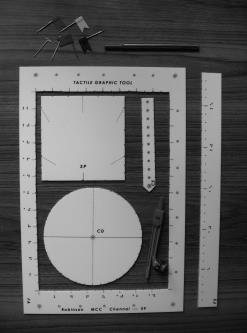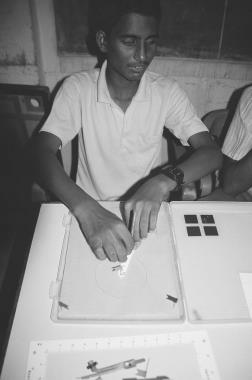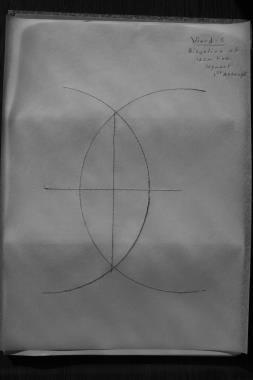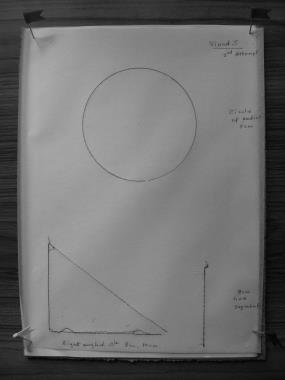MAGIC2VIP: Making Accessible Graphic Information Context to Visually Impaired People
Submitting Institution
Liverpool Hope UniversityUnit of Assessment
Computer Science and InformaticsSummary Impact Type
SocietalResearch Subject Area(s)
Medical and Health Sciences: Neurosciences
Education: Curriculum and Pedagogy, Specialist Studies In Education
Summary of the impact
This project has made a considerable impact on the teaching of Geometry
to school pupils with
visual impairment thus ultimately enhancing their teaching and learning
experience and quality of
life (pupils and teachers from schools in remote villages in the states of
Tamil Nadu; Andhra
Pradesh; and Kerala in India). The Tactile Graphic Tool (TGT) designed as
part of this project is a
device allowing hand exploratory movement in making tactile diagrams of
graphical and
geometrical constructions and then portable digital device (e.g. DigiMemo
A402 or a tablet PC) is
used to make these accessible as digital pictures through the interface of
a computer. The benefits
of the tools developed have been in assisting people with visual
impairment to overcome the
challenge of accessing graphic information contents in mathematics,
including graphs, geometry
and statistical representations. In particular, the case study's impact
represents a practical
demonstration of the potential of technology-assisted learning for
visually impaired students and is
aimed at enhancing their educational and workplace opportunities, as well
as access to popular
media.
Underpinning research
This research is in the area of Human System Interaction-design (or aka
HCI) and underpinning
this impact case study is a HEIF (Higher Education Innovation Funding)
funded project entitled
"MAGIC2VIP: Making Accessible Graphic Information Context to
Visually Impaired People".
The central motivation for the research derives from the fact that the
progressive stages that are
involved in teaching practical geometry, graph constructions and
statistical representations include
exploratory practical experience, which people with visual impairment have
no direct means of
acquiring during their learning process. MAGIC2VIP was, therefore, aimed
to contribute to the
teaching and learning of mathematics education for people with visual
impairment, and enable
them to draw or produce pictures, graphs and diagrams with greater
accuracy and using the same
pedagogical approach that a person with normal vision would adopt.
Graphical information
contents such as graphs, statistical representations, geometry
constructions and technical,
scientific on-line documents that involve mathematical and non-linear
expressions pose a great
challenge to `print disabled' people (persons who are unable to
read standard printed material due
to blindness, visual disability, physical limitations, dyslexia, etc.).
The challenge is much greater for
them while making or drawing such representations. The objective of the
research work was to
mainly make assistive and adaptive devices barrier-free and inclusive
so that picture based non-linear
contents become accessible for print disabled students.
While learning diagrammatic concepts (graphs, statistical
representations, and geometry
constructions), vision-impaired students need to understand the
intermediate stages of drawing or
constructions. So, the assistive device needs to provide an avenue to
explore by hand the
intermediate stages. Similarly, while teaching vision-impaired students
geometric and
diagrammatic concepts, resource teachers or special educators need to
display and demonstrate
the intermediate stages. Hence the need is to design an assistive device
that complies with
universal design principles. The `Tactile Graphic Tool' (TGT)
designed and developed is cost-effective,
adaptive and serves as a tool for an inclusive education environment.
Researchers and Dates of Research: This HEIF funded project was
led by Prof Atulya Nagar of
CAMSS and the research was conducted between October 2009 and June 2013.
It is a joint
collaboration with Dr Robinson Thamburaj, who is a Visiting Senior
Research Fellow at CAMSS
and an Associate Professor of Mathematics at Madras Christian College
(MCC-a partner HEI of
Hope in India); as well as a Disability Science expert Prof Yoshiko
Toriyama, who is a Professor at
the University of Tsukuba, Japan. Dr Thamburaj was on leave from MCC on a
Leverhulme Trust
Visiting Fellowship at CAMSS from 12th October 2009 to 11th
October 2010 and Prof Toriyama
visited the CAMSS during that period. Dr Thamburaj has been associated
with Prof Nagar since
2005/06 and works in the area of Theoretical Computer Science (P-systems)
as well as Disability
Science and Assistive Technology. Since 2010, Dr Thamburaj visits the
CAMSS at least twice
annually and has been working with Prof Nagar (and other members of CAMSS
in general) on this
and other project. The impact of this work took place during April 2010 to
June 2013.
Brief description of Tactile Graphic Tool (TGT) and its modification:
TGT is a set of templates
and frames of 2 mm size white acrylic sheet with v-notches and black
tactile markings placed at
specific positions. The templates include a rectangle perforated
reversible tactile grid plate; a
tactile scale, a tactile circular disc, a tactile square protractor and a
tactile compass scale (as
shown in the Figure). There are pinholes with tactile indications and
v-notches at specific positions.
TGT provided a suitable avenue for exploratory hand movements in the
making of tactile diagrams.
This tool is also mountable on a portable digital pad and makes the
picture or graph drawn as a
digital file simultaneously. For this purpose an A4 sized digital pad
`DigiMemoA402' was identified and used. The DigiMemoA402 is a
device
with storage capability that captures the scripts written or diagrams
drawn on
its surface using ink. The content written or drawn thus is transferred,
organised or edited when connected to a computer. The storage capacity for
number of pages varies depending on the memory storage device. The
annular template (of dimensions 295 mm X 200 mm) with its annular frame is
modified to fit on the A4 size area of the digital pad. A cork sheet of 5
mm
thickness is used as for the pad to sense the inking pen there is a
limitation of
14 mm proximity. Apart from flat headed pins, folded pins are used to mark
coordinate positions of the annular frame. The picture drawn by TGT is
simultaneously stored in
Digimemo. Then the picture content is imported as an e-book file through
pre-installed manager
software in the PC. The picture thus saved can further be edited, resized
or saved as image file
type.

Working principle of TGT: TGT works on a simple principle that when
a stylus or sharp pen is
pressed on a `German film' placed on a soft rubber backing pad, raised
lines are produced.
('German Film' is a translucent and lightly textured polymer sheet.
A touch-detectable raised line
forms when drawn upon with a
simple scriber or ballpoint pen on a
soft rubber-backing pad). TGT is
best utilised when the subject is
taught geometrical and diagrams
using the technique of `progressive
step method' for teaching the
concepts.



Special features of the tool: TGT is
a classroom device for students with
special needs, especially those print
disabled as well as other students
(from specialist secondary schools), thus making it an inclusive
educational geometry drawing kit.
As described above, TGT is a collection of 2mm thick acrylic templates.
The contrast black
coloured Braille, tactile indicators and v-notches provide easy
identification of measurements for
people with low-vision or partial sight and the vision impaired. The
templates, backing rubber pad
etc. are packed in an A4 sized box, making the kit handy and compact.
Safety is considered by
using flat-headed pins, and the edges of the box are curved. TGT is
mountable on a digital note
taker (DigiMemo), hence making digital conversion of hand-drawn diagrams
possible. In the
pictures (with permission from the student) above a fifteen year old `Xth-standard
(year 10)' totally
blind student is shown using the TGT tool (from St. Louis School for the
Blind, Adyar, Chennai,
India — which is a specialist blind school in a remote and hard to reach
village in India whose pupils
are usually from poor and under privileged families). The initial
orientation and first two sessions
took 20 minutes each. After the third session he handled the tool with
ease and was quicker in
drawing basic shapes and plotting and drawing graphs of linear equations.
References to the research
The research from this project was presented in a specialist conference
entitled International
Conference on Computers Helping People with Special Needs (ICCHP),
which is a series of
biannual conferences in the area of ICT/Assistive Technologies (AT) for
people with disabilities and
the aging population. The conference has a tradition over 22 years of
supporting people with
disabilities, run in co-operation with the Johannes Kepler University,
Linz; and the Austrian
Computer Society. The conference proceedings are published in Lecture
Notes in Computer
Science (LNCS), Springer, where output [1] was published. The
extended version of the work was
subsequently published [2] in an Open Access journal entitled: International
Journal of Computer
and Electronics Research (IJCER).
1. Thamburaj, R. and Nagar, A. K. (2010). Tactile Graphic Tool for
Portable Digital Pad, In:
Proceedings of the 12th international conference on Computers
Helping People with Special
Needs, Lecture Notes in Computer Science (LNCS), Vol. 6180,
Springer-Verlag Berlin, page
403. DOI: 10.1007/978-3-642-14100-3_60.
2. Thamburaj, R. and Nagar, A. K. (June 2013). Adapting Tactile
Graphic Tool for Portable Digital
Pads and Tablet PCs. International Journal of Computer and
Electronics Research (IJCER),
Vol. 2, Issue 3, page 33. ISSN: 2278-5795.
The research was done during Dr Robinson Thamburaj's visit to CAMSS on a
Leverhulme Trust
Visiting Fellowship from 12th October 2009 to 11th
October 2010 and then work continued until
June 2013. HEIF funding was used for the development of the TGT took-kit
(including the
purchase of materials etc) and participation in the ICCHP conference
(output [1]).
Details of the impact
Prior to the experience of using TGT, students were only using a Taylor
frame for making basic
shapes while studying geometry. The procedure of geometric constructions
was dictated by the
class teacher and was written as Braille notes; the students memorised
those procedures. In the
examination, the students used to narrate the memorised procedure of the
constructions and the
scribing sighted volunteers did the actual drawing of the construction. In
the experiment using
`Tactile Graphic Tool' as part of this project, the students made the
tactile geometrical pictures of
polygons and lines by themselves. They could also draw geometrical
constructions by themselves
with this assistive device. The students were excited that it was
their first ever experience of
drawing tactile diagrams. The orientation session was time
consuming, as the subjects had to
familiarise with the templates and learn the hand and finger coordination
of holding the templates
and drawing. The tactile drawings of shapes on microcapsule (swell) paper
were found to be
essential in the initial sessions. The quality of the drawings improved
significantly after the subjects
learned to apply less pressure and coordinate the hand accordingly. With
TGT, these print disabled
students were able to make tactile (raised line) diagrams of graphs,
geometrical shapes and
statistical diagrams as any normal student would do in mainstream
regular classes. This
enhanced the understanding of drawing mathematical diagrams. The TGT tool
was used with
students of specialist Blind schools (e.g. St. Louis School for the Blind,
Adyar, Chennai, India)
which are in remote, hard to reach, village areas and the students
themselves are from poor and
underprivileged families.
The impact of the research on improving the teaching and learning
processes of visually impaired
students has been acknowledged by special education centres for the blind
in India and the UK,
such as: St Vincent's specialist school for sensory impairment and other
needs at Liverpool;
specialist blind schools in India; UNESCO India; and the Government of
India/Tamil Nadu in India.
The impact of this research has been well demonstrated at an
internationally recognised centre
committed to supporting blind and partially sighted people, namely the National
Institute of Visually
Handicapped (NIVH) at Chennai (India). The NIVH is a leading charity
offering information, support
and advice to almost two million people with sight loss and visual
impairment, and are passionately
committed to providing technological support to enable the blind and
partially sighted to live an
independent and fulfilled life. NIVH is a premier Institute in the field
of visual disability, working
under the administrative control of the Ministry of Social Justice and
Empowerment of the
Government of India. The Institute is concerned with the task of
empowering the visually
handicapped by encouraging and supporting the development of innovative
technologies. The
choice of NIVH to deliver this strategic vision of Hope was on the basis
that NIVH is a leading
organisation for blind and visually impaired people, and shares the same
vision of empowering the
visually handicapped through the use of innovative technologies centred on
people-oriented
requirements. This ensures that the MAGIC2VIP research has had a
significant and broad impact,
across geographies, on the educational empowerment of the blind and
partially sighted people. As
mentioned above, this project on the use of TGT was piloted with St.
Louie's School for the Blind in
Chennai, including tools to teach Kolam patterns and play Sudoku. Staff
and students of NIVH and
St. Louie's School were involved in all stages of the design and
development of the TGT tool to
ensure that usability issues were adequately met. Each aspect of the tool
has been tied into
current knowledge of geometry and technology-supported learning for the
visual impaired. At NIVH
specific activities were used to broaden the reach of the MAGIV2VIP, which
highlighted particular
impacts as detailed below:
1. The Government of India through the National Institute for Visually
Handicapped (NIVH)
conducts human resource development programmes for special educators and
resource
teachers of blind schools. The Rehabilitation Council of India (RCI), the
nodal agency that
regulates and monitors the services given to persons with disability in
India, approves these
programmes. The southern Regional Centre of NIVH at Chennai conducted
training programmes
for resource teachers and special educators of schools from rural
districts of the southern states
Tamil Nadu, Kerala, Andhra Pradesh during 2012 and 2013. The techniques
and tools
developed and modified through MAGIC2VIP at Liverpool Hope University were
introduced and
demonstrated at the training programme on "Teaching Algebra and
Geometry at Post-primary
level" (10 - 14 December 2012) and a refresher course on "Teaching
Arithmetic at Primary level"
(28 January — 1 February 2013). The students and teachers who had the
hands-on experience
felt they had benefitted and gave their feedback, some of which is given
below (some of the
feedback sheets are in Tamil language and can be obtained from the HEI):
(a) "it is much better than the existing tool because of its
simple method with very few steps to
draw tactile pictures"; (b) "Yes, In a single board students can
learn graph, geometry, drawing any
shapes"; (c) "It will be easy to learn and draw by the visually
impaired & totally blind"; (d)
"measurements can be drawn precisely" (translated from Tamil); (e)
"it is better to handle than
wooden models" (translated from Tamil); (f) "It is easy to handle
for the visually impaired children";
(g) "I can teach the steps better to my students through this tool"
(translated from Tamil); (h) "better
than existing device, very clear methods"; (i) "it is totally
different from ordinary tools"; (j) "looking
nice, attractive and weightless also".
2. The TGT tool (geometry kit) has become a key resource for teaching
mathematics and tactile
geometry in many of the government sponsored workshops conducted by NIVH.
3. Potential avenues for patenting the TGT tool have been highlighted in
discussions with
interested stakeholders concerned with supporting the visually impaired,
and are being pursed.
In a letter from the Regional Director of NIVH, he noted that he would be
delighted to see any
concrete steps taken towards making the TGT tools available for the need
and benefit of
students in blind schools.
4. During the workshop at Hope, Prof Toriyama demonstrated tools for
teaching Science in general
and Geometry in particular; she did a public demonstration so that
participants from local schools
could see and consider the work being done and the philosophy. This
workshop was very well
received and some very valuable feedback was collated. The feasibility of
using the TGT tool kit
as inclusive, cost effective and portable make this relevant for math and
statistical education in
any developing nation.
This work continues to progress as a joint project between MCC (India)
and Hope, with on-going
discussions about a joint spin-off company for mass production and supply
of the Geometry toolkit
to specialist schools in India and outside India, including Africa and the
UK; discussions are also
on-going with the St Vincent's school in Liverpool.
Sources to corroborate the impact
The sources (available from the HEI) for corroborating the impact of the
MAGIC2VIP project
include:
- Letter from the Regional Director, NIVH — named contact details
have been provided; NIVH
has compiled the feedback from the participants of the programme and
refresher course,
acknowledged the contributions of MAGIC2VIP and recommended suggestions
for the future
work too.
- UNESCO Invitation Letter — confirming the usefulness of the toolbox.
- Feedback from Students and Teachers (i.e. special educators and
resource teachers); this
feedback was collected using a questionnaire (approx. 60 respondents)
after the TGT tool-box
was used with the specialist blind school pupils and teachers.
- Email/letter from Ms Marie Quinn, Sensory officer of RNIB; Expression
of interest and feedback
email(s) from meetings/demos with officials of RNIB, London; St
Vincent's School at Liverpool.
Additional evidence in the form of posters, letter of appreciation and
awards:
Evidence of a workshop organised at Hope — Prof Toriyama presented a
workshop on teaching
science to visually impaired students and the toolbox was used as a demo.
Letter of evidence from
the President's Office, Indian Government and letter of appreciation/award
by the Tamil Nadu
Government given to Dr Thamburaj.